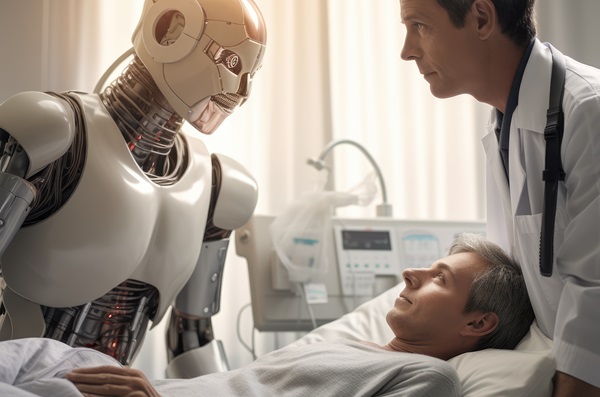Robotics involves the design and use of machines to perform tasks traditionally carried out by humans. This technology is revolutionizing various industries by enhancing efficiency, precision, and safety. In manufacturing, robotics automates repetitive tasks, increasing productivity and reducing human error. In logistics, robots streamline warehousing and delivery operations. The impact of robotics extends to healthcare, where it transforms patient care and medical procedures. Robotic systems in healthcare enhance surgical precision, assist in rehabilitation, and improve overall patient outcomes, showcasing the technology’s significant benefits across diverse fields.

I. Introduction
A. Overview of Robotics in Healthcare
Robotics in healthcare represents a transformative shift in medical technology, integrating advanced robotics to enhance precision, efficiency, and patient outcomes. From surgical robots to rehabilitation devices, robotics is revolutionizing various aspects of healthcare by introducing innovative solutions that improve both patient and provider experiences. These technologies leverage precision engineering, artificial intelligence, and automation to tackle some of the most challenging medical procedures and tasks.
B. Importance of Robotics for Enhancing Medical Procedures
The importance of robotics in healthcare cannot be overstated. By offering greater accuracy and control, robotics minimizes human error and enhances the effectiveness of medical interventions. Surgical robots, for example, enable minimally invasive procedures that reduce recovery times and improve surgical outcomes. Rehabilitation robots assist patients in regaining mobility and strength more effectively than traditional methods. As healthcare continues to evolve, robotics plays a crucial role in pushing the boundaries of what is possible in medical treatment and care.
C. Objectives of the Article: Exploring How Robotics is Transforming Healthcare
This article aims to explore how robotics is transforming healthcare by examining its various types, benefits, and impact on medical procedures. We will delve into how robotics enhances precision, increases efficiency, and improves patient outcomes. Additionally, we will discuss the integration of robotics with other technologies, the challenges faced, and future trends in this dynamic field.
II. Types of Robotics in Healthcare
A. Surgical Robots
1. Overview and Capabilities
Surgical robots represent a significant advancement in medical technology, designed to assist surgeons with high precision and control. These robots typically feature robotic arms that can perform complex movements with unparalleled accuracy. They are equipped with advanced imaging systems that provide real-time feedback, allowing surgeons to make precise adjustments during operations.
2. Examples of Leading Surgical Robotic Systems
Some leading examples of surgical robots include the Da Vinci Surgical System and the ROSA Robotic System. The Da Vinci system is widely used for minimally invasive surgeries, such as prostatectomies and hysterectomies, due to its high precision and flexibility. The ROSA system, on the other hand, is used in neurosurgery and orthopedic procedures, offering enhanced precision and reduced recovery times.
B. Rehabilitation Robots
1. Role in Physical Therapy and Recovery
Rehabilitation robots play a vital role in physical therapy and patient recovery by assisting with repetitive exercises and movements. These robots are designed to support patients in regaining strength, mobility, and coordination after injuries or surgeries. They provide consistent and accurate therapy, which can lead to faster and more effective recovery.
2. Key Technologies and Innovations
Key technologies in rehabilitation robots include exoskeletons and robotic arms. Exoskeletons are wearable devices that help patients walk and move by providing support and assistance to their limbs. Robotic arms are used for targeted exercises, such as reaching and grasping, to improve motor skills and muscle strength.
C. Service Robots
1. Robots for Patient Assistance and Care
Service robots in healthcare assist with various tasks, including patient monitoring, medication delivery, and even companionship. These robots help improve patient care by providing timely and accurate support, allowing healthcare providers to focus on more complex tasks.
2. Innovations in Hospital Logistics and Administration
In addition to direct patient care, service robots are revolutionizing hospital logistics and administration. Robots are used for transporting supplies, cleaning, and managing inventory, thus streamlining hospital operations and reducing the burden on healthcare staff.
III. Enhancing Precision in Medical Procedures
A. Benefits of Robotic Assistance in Surgery
1. Minimally Invasive Techniques and Precision
Robotics in healthcare has significantly advanced minimally invasive surgical techniques. By utilizing robotic systems, surgeons can perform operations through smaller incisions, resulting in less pain, shorter recovery times, and reduced risk of infection. The precision of robotic systems allows for more accurate tissue manipulation and better overall outcomes.
2. Case Studies: Successful Robotic Surgeries
Numerous case studies highlight the success of robotic surgeries. For instance, robotic-assisted laparoscopic surgery for prostate cancer has shown improved outcomes in terms of cancer control and postoperative recovery. Similarly, robotic heart surgeries have demonstrated reduced complications and quicker recovery compared to traditional open-heart procedures.
B. Improving Accuracy in Diagnostic Procedures
1. Robotic Tools for Imaging and Analysis
Robotic tools are enhancing diagnostic procedures by providing more accurate imaging and analysis. Technologies such as robotic-assisted biopsy systems enable precise tissue sampling, while advanced imaging robots improve the quality and clarity of diagnostic scans.
2. Examples of Enhanced Diagnostic Capabilities
Robotic systems like the Robotic Ultrasound System and the iRobot’s Diagnostic Imaging System exemplify enhanced diagnostic capabilities. These systems offer improved resolution and accuracy, leading to better diagnostic outcomes and more effective treatment plans.

IV. Increasing Efficiency in Healthcare Delivery
A. Streamlining Surgical Processes with Robotics
1. Time Savings and Reduced Recovery Periods
Robotic systems in surgery streamline processes by allowing for more precise and efficient operations. This efficiency results in reduced operating times and quicker patient recovery. For example, robotic-assisted surgeries often lead to shorter hospital stays and faster return to normal activities.
2. Impact on Operating Room Efficiency
The integration of robotics in operating rooms has improved efficiency by reducing the need for multiple surgical team members and minimizing the time required for complex procedures. This enhanced efficiency translates into better utilization of resources and more effective patient care.
B. Automation in Patient Care and Hospital Operations
1. Efficiency Gains in Routine Tasks
Robotics in healthcare also contributes to efficiency gains in routine tasks. Automated systems for medication dispensing, patient monitoring, and data management help streamline hospital operations and reduce manual errors.
2. Role of Robotics in Reducing Human Error
Robotic systems reduce human error by automating repetitive and precise tasks. This automation ensures consistency and accuracy in procedures and patient care, leading to improved overall outcomes and safety.
V. Improving Patient Outcomes with Robotics
A. Enhanced Recovery and Rehabilitation Processes
1. Benefits of Robotic Rehabilitation Devices
Robotic rehabilitation devices offer significant benefits in recovery and rehabilitation. These devices support patients in performing exercises that improve strength, flexibility, and coordination. They also provide real-time feedback and adjustments to enhance the effectiveness of therapy.
2. Case Studies: Patient Success Stories
Success stories from robotic rehabilitation highlight the positive impact on patient outcomes. For example, patients using robotic exoskeletons have achieved remarkable improvements in mobility and independence, demonstrating the effectiveness of these technologies in recovery.
B. Reducing Complications and Enhancing Safety
1. Lower Risk of Infection and Surgical Errors
Robotics in healthcare helps reduce complications by minimizing the invasiveness of procedures and improving precision. This reduction in invasiveness lowers the risk of infection and surgical errors, contributing to safer and more successful outcomes.
2. Robotics for Precision in High-Risk Procedures
Robotic systems are particularly beneficial for high-risk procedures, where precision is critical. For instance, robotic-assisted surgeries for cancer treatment and complex orthopedic procedures have demonstrated enhanced accuracy and reduced risk, improving overall patient safety.
VI. Integration of Robotics with Other Technologies
A. Combining Robotics with Artificial Intelligence
1. AI-Powered Decision Support and Automation
The integration of robotics with artificial intelligence (AI) enhances decision support and automation in healthcare. AI algorithms analyze data from robotic systems to provide insights and recommendations, improving the accuracy and efficiency of medical procedures.
2. Examples of Integrated Systems in Use
Examples of AI-integrated robotic systems include surgical robots with AI-assisted navigation and diagnostic tools with AI-powered imaging analysis. These systems combine the strengths of robotics and AI to offer advanced capabilities and improved outcomes.
B. Robotics and Telemedicine
1. Remote Surgery and Consultation Capabilities
Robotics and telemedicine are transforming patient care by enabling remote surgery and consultations. Robotic systems allow surgeons to perform procedures from a distance, while telemedicine platforms facilitate remote consultations and monitoring.
2. Enhancing Accessibility and Patient Care
The integration of robotics with telemedicine enhances accessibility and patient care by providing remote access to specialized medical services. This integration is particularly valuable for patients in underserved or remote areas, improving healthcare delivery and outcomes.

VII. Challenges and Limitations of Robotics in Healthcare
A. High Costs and Accessibility Issues
1. Financial Barriers for Healthcare Facilities
The high cost of robotic systems presents financial barriers for many healthcare facilities. The initial investment, maintenance, and training costs can be significant, impacting the accessibility of these technologies.
2. Addressing Cost vs. Benefit Considerations
Healthcare facilities must carefully weigh the costs and benefits of robotics in healthcare. While the initial investment can be high, the long-term benefits, such as improved outcomes and efficiency, may justify the expenditure.
B. Technical Challenges and Reliability
1. Maintenance and Technical Issues
Technical challenges and maintenance issues can impact the reliability of robotic systems. Regular maintenance and timely repairs are essential to ensure the continued performance and safety of these technologies.
2. Ensuring System Reliability and Safety
Ensuring the reliability and safety of robotic systems is crucial for effective healthcare delivery. Robust testing, quality assurance, and ongoing monitoring help address potential technical issues and maintain system performance.
C. Training and Adaptation for Healthcare Professionals
1. Training Requirements for Effective Use
Healthcare professionals require specialized training to effectively use robotic systems. Comprehensive training programs are essential to ensure that medical staff can operate and maintain robotic technologies safely and efficiently.
2. Overcoming Resistance to New Technologies
Overcoming resistance to new technologies involves addressing concerns and providing support for healthcare professionals. Effective communication and training can help ease the transition and encourage the adoption of robotics in healthcare.
VIII. Future Trends in Robotics in Healthcare
A. Innovations on the Horizon
1. Emerging Technologies and Advancements
The future of robotics in healthcare is marked by emerging technologies and advancements. Innovations such as more advanced surgical robots, enhanced rehabilitation devices, and improved service robots are expected to further transform the field.
2. Predictions for Future Developments
Predictions for future developments in robotics include increased integration with AI, advancements in telemedicine, and the continued evolution of robotic systems to meet the growing demands of healthcare.
B. The Role of Robotics in Personalized Medicine
1. Tailoring Robotics for Individual Patient Needs
Robotics in healthcare is increasingly being tailored for individual patient needs, offering personalized treatment options and interventions. This customization enhances the effectiveness of robotic systems and improves patient outcomes.
2. Integration with Genomic and Precision Medicine
The integration of robotics with genomic and precision medicine enables more targeted and effective treatments. By combining robotic technologies with genetic information, healthcare providers can offer personalized care based on individual patient profiles.
IX. Case Studies and Examples
A. Analysis of Successful Robotic Healthcare Implementations
1. Notable Hospitals and Clinics Using Robotics
Case studies of notable hospitals and clinics using robotics highlight the successful implementation of these technologies. Facilities such as Johns Hopkins Medicine and the Mayo Clinic have demonstrated the benefits of robotics in improving patient care and operational efficiency.
2. Impact on Patient Outcomes and Operational Efficiency
The impact of robotics on patient outcomes and operational efficiency is evident in these case studies. Improved surgical outcomes, enhanced rehabilitation processes, and streamlined hospital operations showcase the positive effects of robotic systems.
B. Lessons Learned and Best Practices
Lessons learned from successful implementations provide valuable insights for other healthcare facilities. Best practices for integrating robotics into medical settings include careful planning, training, and ongoing support to ensure successful adoption and utilization.
X. Conclusion
A. Recap of the Benefits and Impact of Robotics in Healthcare
Robotics in healthcare offers significant benefits, including enhanced precision, increased efficiency, and improved patient outcomes. The integration of robotic systems into medical procedures and care has transformed various aspects of healthcare, leading to better results and more effective treatments.
B. Strategic Recommendations for Implementing Robotics in Medical Settings
To maximize the benefits of robotics in healthcare, strategic recommendations include investing in advanced technologies, providing comprehensive training, and addressing financial and technical challenges. These strategies will help healthcare facilities successfully implement and utilize robotic systems.
C. Final Thoughts on the Future of Robotics and Healthcare Innovation
The future of robotics in healthcare is promising, with continued advancements and innovations on the horizon. As robotics technology evolves, it will play an increasingly important role in shaping the future of healthcare, improving patient care, and enhancing medical outcomes.

